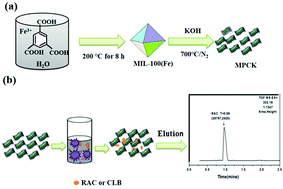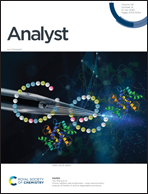Synthesis of 3D magnetic porous carbon derived from a metal–organic framework for the extraction of clenbuterol and ractopamine from mutton samples†
Abstract
3D magnetic porous carbon (MPCK) was prepared using the metal–organic framework (MOF) MIL-100(Fe) as the carbon precursor by carbonisation and KOH activation strategies. Carbonisation and activation ensured that MPCK possessed excellent structural and thermal stability, strong magnetic responsiveness and high surface area. MPCK was used as an adsorbent for the magnetic solid-phase extraction of clenbuterol and ractopamine from mutton samples. The concentration levels of analytes were determined by ultra-high performance liquid chromatography-mass spectrometry. Under optimised extraction conditions, the peak area responded linearly to analytes over the concentration range from 0.05 μg L−1 to 40 μg L−1 (r ≥ 0.9972). The detection limits of clenbuterol and ractopamine were found to be 0.130 μg kg−1 and 0.150 μg kg−1, respectively. The satisfactory recoveries in mutton samples ranging from 95.64% to 114.65% indicated that 3D porous carbon is a promising adsorption material for the extraction of clenbuterol and ractopamine from complex biological matrixes.



 Please wait while we load your content...
Please wait while we load your content...